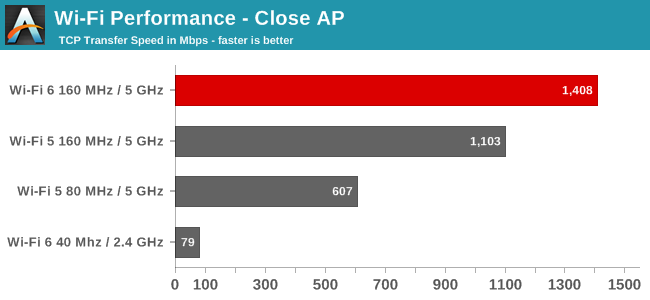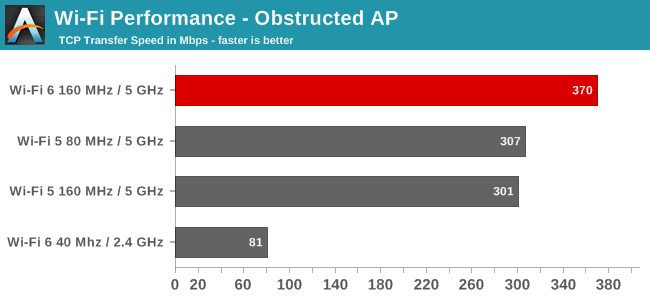AT 101: Wi-Fi 6 And Why You Want It
by Brett Howse on February 12, 2020 8:00 AM ESTPerformance
In order to achieve maximum performance, the latest Wi-Fi 6 standard leverages 1024-level QAM, but depending on the signal strength and quality it will scale down as needed, so to achieve the best performance very high signal to noise ratios are going to be required. Since 5 GHz is attenuated dramatically when it has to go through walls, if you need maximum Wi-Fi performance be aware that you are going to want your wireless router as close to the end device as possible. Luckily that is not an issue in our case, since the router is in the same room when testing for maximum performance, but we’ll also evaluate it in less than ideal scenarios as well.
Wi-Fi 5 vs Wi-Fi 6 – Close AP
First up we’ll test the TCP performance when the Access Point is in the same room as the client.

The performance advantages of Wi-Fi 6 are clear. With the access point in the same room, the SNR is very good and the new 802.11ax standard can really shine. With 1024 QAM and 160 MHz channels, the performance is over twice as fast as the outgoing Wi-Fi 5 with 256 QAM and 80 MHz channels. It is very impressive to see a typical 2x2:2 connection well over the Gigabit barrier, and even though the AX200 network card is the first generation, Intel has already done a fantastic job tuning it. The theoretical maximum transfer rate with 160 MHz channels and 1024 QAM is around 1200 Mbps per connection, so a 2x2 can in theory hit around 2.4 Gbps, meaning there's still room for improvement. Since 802.11ax also can be used on the 2.4 GHz frequency, unlike 802.11ac, the same test was also done on 2.4 GHz, and the results were disappointing. 2.4 GHz can still offer 40 MHz channels, but it doesn’t seem like the AX200 could take advantage of any of that. For reference, the wireless adapter in the laptop was reporting -21 dBm, which is a strong signal, which makes sense since the AP is almost right next to the laptop.
Wi-Fi 5 vs Wi-Fi 6 – Reduced Signal
Moving the laptop further away, and adding several walls and doors in the way to attenuate the signal, the same scenarios were again tested.

With some walls in the way, 5 GHz gets attenuated quite dramatically, and the SNR in the second location was -78 dBm. With such a low signal, the Wi-Fi 6 connection wasn’t able to take advantage of the 1024-level QAM and would have had to drop down to a much lower set, reducing the number of bits per tone, and even though the total channel bandwidth was still 160 MHz, it was only marginally faster on 802.11ax than 802.11ac 80 MHz. 2.4 GHz is not as impacted by walls, and as such was able to maintain the same transfer rate, even though it was still quite a bit slower.
So the results are clear. Wi-Fi 6 can offer a significantly higher level of throughput than Wi-Fi 5, but in order to do so, it needs a strong signal. The Wi-Fi 6 still outperformed the Wi-Fi 5 in the second test with an attenuated signal, but the performance gain was minimal. 2.4 GHz still offers the best signal strength, and therefore would be able to connect further away, and through more obstacles, but doesn’t offer anywhere near the performance of the 5 GHz range. It will be interesting to see the Wi-Fi 6E devices with 6 GHz support when they launch. It will open up Wi-Fi to a wider set of frequency choices, but will offer even less range.










149 Comments
View All Comments
Makaveli - Wednesday, February 12, 2020 - link
Not quite that high.Ontario remained, by far, the most populous province in Canada with 13.4 million people calling it home in 2016, representing 38.3% of the Canadian population. This share was down slightly from the 100-year high of 38.5% in 2006.
So for american's you would consider Ontario the state.
And Ontario is a pretty big land mass 415,600 mi²
https://www150.statcan.gc.ca/n1/daily-quotidien/17...
Flunk - Wednesday, February 12, 2020 - link
Look up a population map, the vast majority of Ontario is sparsely populated, the area around Toronto & Hamilton is densely populated.andrewaggb - Wednesday, February 12, 2020 - link
In western canada your fastest options from the major providers are Telus gigabit 940/940 or Shaw Cable 600/20Neither needs more than a gigabit port. I'm sure telus could do faster but they aren't offering it.
mdrejhon - Thursday, February 13, 2020 - link
Buddy, something like ~25% of Canada lives within 2 hours drive of Toronto. There's millions of houses with access to gigabit connections.I'm in Canada and I'm on gigabit (Cogeco UltraFibe) and Bell is coming to lay fiber, so we'll have 2 gigabit ISPs competing in my city (lowly Hamilton)
Sure, if you go to the artic or the middle of our vast Canadian farmlands, it's crappy Internet. But if you go to populated Canada, there's lots of good Internet connections in urbanized Northeast Corridor now.
sonny73n - Friday, February 14, 2020 - link
“Canada is barely faster than Mexico”So they both have super fast internet compared to the where I live - the US. I only get 1.5 Mbps from the only ISP available in my area which is AT&T. Only basic internet available, no fiber. Don’t believe me? Open google maps and pick an address around Harbor Blvd. & Westminster Ave. CA. 92843. This is a super crowded area and we can only get 1.5 Mbps. All the subsidizes they got the government to upgrade their broadband towers have gone into their own pockets and the government do nothing. What a fucking joke.
Holliday75 - Wednesday, February 12, 2020 - link
Terrible for people in farmland sure. Got 100mbps around 12 years ago. 3 years ago I moved to a new ISP that uses FTTH. 500/500mbps for $70 a month. I can get 1gbps for another $20 a month, but see no reason for it. Even when downloading movies, large games, etc 500mbps is fast enough for me. Been quite pleased with it. Chicagoland overall has pretty good access to high speed offerings. Even the satellite cities are getting fiber now since prices on infrastructure has dropped so much the last 10 years.Dragonstongue - Wednesday, February 12, 2020 - link
say WHERE not just "in Canada" as I know am from and living in..Fiber is far far more promised than readily availableA
and
B
for the most part (meaning most of Canada) internet and telecoms overall are wickedly overpriced with moronic staging for the price point
lets see, get rid of majority of DSL that took a long time to even offer unlimited option, while also being on average ~$65/mth (including, sometimes without tax) for often sub 5/.768 connections, then they jack up price of standard phone lines (too expensive to maintain)
then they turn around pretty much make all other "we will call" high speed, sometimes 10/1 more often than not, lucky to stable 5/0.5, unless you were "very fortunate" to live in major city (even then) hit and miss STABLE above 20+DL 1-2UL ~$50-$110/mth plus tax only when in bundles.
Now they are wanting everyone on "wireless" to get away from all other types as although infrastructure is pricey (initially) after that, is dirt cheap to support thousands of customers per "tower" with few antennas to handle it (due to MIMO style)
when Fiber (which seems to be all over the country is actually "wired up" that would be one thing, but for now, generally quite overpriced (even when federal and provincial govt.) gave the telecoms many 10s of millions to "wire up the country by X date) and of course, things like CRTC seem to not give 2 shits.
...maybe because we all have full time bring in $100k per year in pocket jobs or something....yeh @#$ right.
as far as major ISP got rid of data caps in Canada years ago...I want some of that #$% you smoking, unless you the expensive (very limited) offerings, sorry, but no ALL telecoms in Canada still VERY MUCH have data caps....not everyone can afford $80+ per month internet PLUS phone + TV just to get the "unlimited" (to a point) bandwidth (data) allowance.
more often than not, folks living in Rural (which I currently do) NO LONGER have this option, unless you want to massively downgrade speed available, for the same price right around ~90 after tax.
folks should be far more "legit" in what they say (myself included) such as "I live in a condo in Vancover, or Montreal where internet is dirt cheap, sorry the rest of you @#$ do not"
^.^
Makaveli - Wednesday, February 12, 2020 - link
I live in Toronto.And I was a rogers internet customer for about 15 years I haven't had a data capped connection in 10+ years. I cannot speak for your experience.
And you sound like you suffer from living in a small town which is a problem the US shares. If you want good internet you are screwed living in Rural in North America, so either move or stay and deal.
Samus - Thursday, February 13, 2020 - link
Right, I have a Gigabit, full duplex (980/960) uncapped connection from AT&T Fiber for $70/mo in Chicago...I don't see any limitation of using a router with a Gigabit LAN port.Are there any beyond Gigabit ISP providers on the planet for residential use?
Willx1 - Thursday, February 13, 2020 - link
Minneapolis has had 10gbps fiber at $400/month for a while now. Not sure on specifics but they were apparently the first in the US to offer it to consumers.where I live with about 100k in the metro area (small area I know) in the city we are stuck with one cable provider midco. They do have fiber to the node but not the home because if cost, but a government subsidized company that offers ftth isn’t allowed in city limits and offer gbps speeds at much cheaper prices. In fact I worked for a company that did a lot of the underground work in the western half of my state and even the rural areas (including farms and ranches)have fiber to the home while the city centers don’t. So the times of rural areas either having satellite or dsl are long gone, at least in my state.